The Global Prehistoric Culture
Ancient Earthworks of North America suggest pre-Columbian European contact
Postcard image of the Serpent Mound, Ohio (Wikimedia Commons)
Long before the Isolationist doctrine of the Smithsonian became an academic dogma, mounds and earthworks in America were routinely compared to those observed in Western Europe. This position was summed up by Stephen Denison Peet, founder of the American Antiquarian, in these passages from 1892:
"Relics of the Mound builders resemble those found in Great Britain and the north of Ireland, and even suggest the transmission of the same myths and symbols from the eastern to the western continent."
"The contact seemed to have produced a marvelous effect. It was not a decline from the Bronze Age which we see in these familiar symbols, but the effect of contact with European voyages in pre-Columbian times, pre-Columbian discovery, in fact. The conclusion is startling, but this is the only way that we can account for the marvelous resemblances."
Connection between the Serpent Mound of Ohio
and ancient earthworks of Britain
"…we think it can be proven that the most striking features of the work at Avebury are duplicated here; the sun symbol being embodied in the concentric circles on the Kentucky side; the phallic symbol in the horse-shoe mounds upon the Ohio side and the avenues of standing stones corresponded to the covered ways which connected the enclosures on the Kentucky side with that on the Ohio side."1
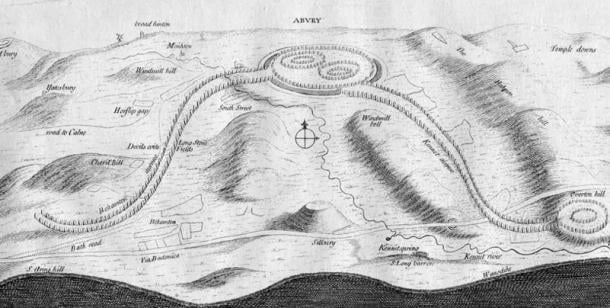
John Aubrey sketch of the entire Avebury
complex and the enormous processional avenues that once led to it (Ancient
Skies)
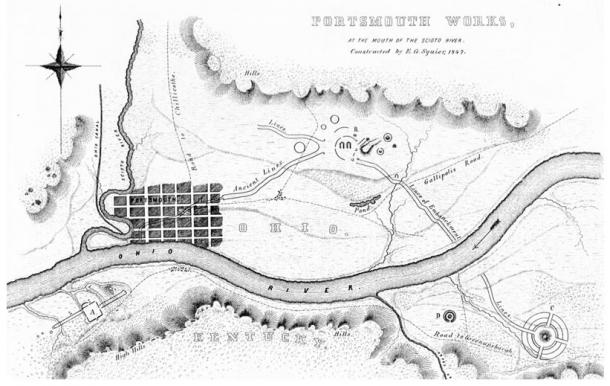
Portsmouth, Ohio Earthworks, from Ancient
Monuments of the Mississippi Valley (Wikipedia)
“It has, however, a counterpart in the Old World. In Great Britain, as is well known, there are frequent remains of a race of people similar to, if not identical with, the Mound Builders of America...In Scotland there is a very remarkable and distinct serpent, constituted of stone.”2

Left: Serpent Mound at Loch Nell taken from
Constance Cumming's In the Hebrides (1883). Right: The Serpent Mound in
Ohio (Wikimedia
Commons)
Connections between Bell Beaker and Corded
Ware Cultures of Europe and Adena Culture of North America
Recent genetic studies show that the Corded Ware Culture originated with mass migrations of the Yamnaya Culture from the Pontic Steppe into Northeastern Europe between 3000 and 2800 B.C.3 The Yamnaya Culture buried their dead in pits beneath small mounds, sometimes covering the bones in red ocher, while Corded mounds demonstrate regional diversity and sophistication.
The Beaker People expanded out of the Iberian Peninsula into Western Europe and the Mediterranean between 2900 and 2500 B.C. They are credited with introducing metallurgy into Ireland and Britain. The Beaker People practiced individual burials inside of a variety of round conical mounds (“Disk Barrows”, “Bell Barrows”, and “Bowl Barrows”), and continued the Megalithic culture of their Neolithic forbears, including construction of large circular henges and the reuse of earthworks already built.
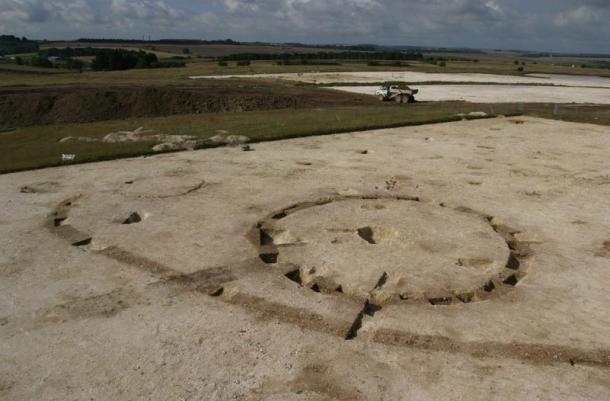
Early Bronze Age barrow and enclosure, Boscombe
Down, Amesbury. Beaker pottery was retrieved from the central burial and the
barrow ditch. (Wessex Archaeology / Flickr)
Many of the North American earthworks compared with those across the Atlantic were built by the Adena People. Adena enclosures are circular embankments of earth with interior or exterior ditches, featuring openings possibly referencing solar, lunar, or otherwise astrological events, usually located among mound fields. The enclosures sometimes had timber circles incorporated into their designs.
These structures are comparable to Neolithic and Bronze Age henges. Some henges (such as Arbor Low) surround megalithic circles. Stonehenge began life around 3100 B.C. as a simple circular enclosure with the ditch outside of the embankment.

Left: Mt Horeb Earthworks in Kentucky, USA (Kentucky Heritage Council). Right: Goseck Circle, Germany (Patrick G / Flickr)
So strong are the similarities of these works from both sides of the Atlantic that mainstream archaeologists occasionally study the European examples when interpreting the Adena versions.6
Adena mounds of North America resemble burial
mounds of Europe
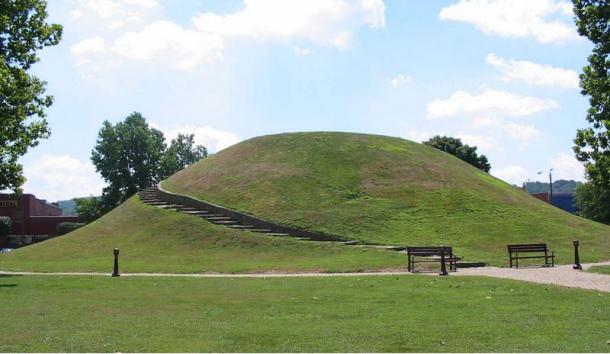
Criel Mound, Charleston. (Wikimedia Commons)
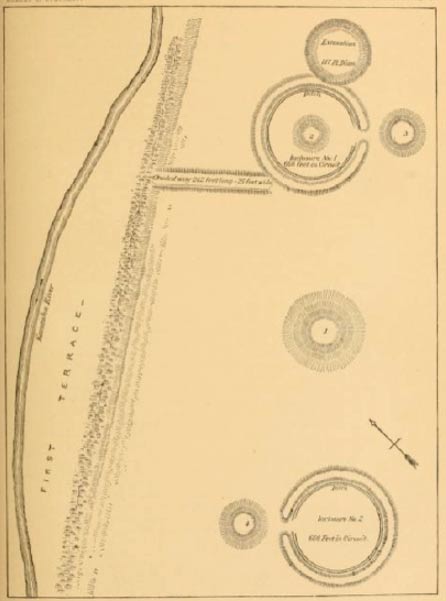
Charleston, W.V. earthworks. 5th
Annual Report of the Bureau of Ethnology. Courtesy of Archive.org. Enclosure #1
is the large ring in the top half of the map, while Enclosure #2 is the large
ring in the bottom half.
At the center of a level area inside Enclosure 1 was a small mound, 40ft broad and 4ft high,7 similar to a European “Disk Barrow”.
“The ‘Druid’ barrow, of Stukeley, belongs to this category, and consists of one or more very small mounds with a circular bank surrounding them at some distance.”9
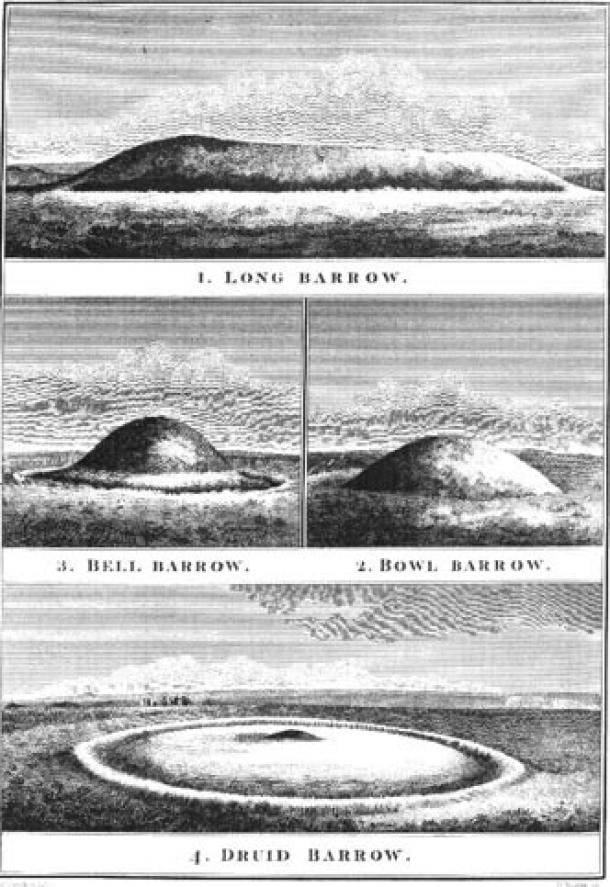
Types of Burial Mounds in Western Europe by
Richard Colt Hoare (Wikipedia).
Another mound near these works, known as the Wilson Mound, was 15 feet high and surrounded by a circular enclosure “enclosing about 40 acres, having the ditch inside of the embankments which were originally 5 or 6 feet high…”.7 This Mound and enclosure had precisely the same design as a European Bronze Age Bell Barrow, described here by Vere Gordon Childe:
“Here the mound is surrounded by a ditch or fosse with a bank outside it; a narrow belt of level ground, known as the berm, generally intervenes between the inner lip of the encircling fosse and the base of the mound proper.”10
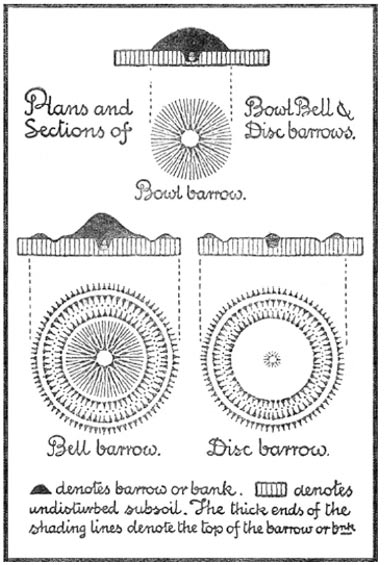
Designs and profiles of European Barrows
(Gutenburg)
A subsequent excavation of the Wilson Mound revealed a female skeleton with copper implements:
“There had been copper bands around the ankles and wrists and larger pieces of copper on each breast.”8
Other Adena mounds of Bell Barrow design

Sketch of the Biggs Site in Kentucky, a part
of the Portsmouth Earthworks, from Ancient Monuments of the Mississippi Valley,
courtesy of scienceviews.org
In Marietta, Ohio, the Conus Mound (originally 30ft high) still stands within an earth wall and surrounding ditch. Conus is recognized as an Adena mound even though the accompanying Marietta Earthworks are assigned to the Hopewell Culture.
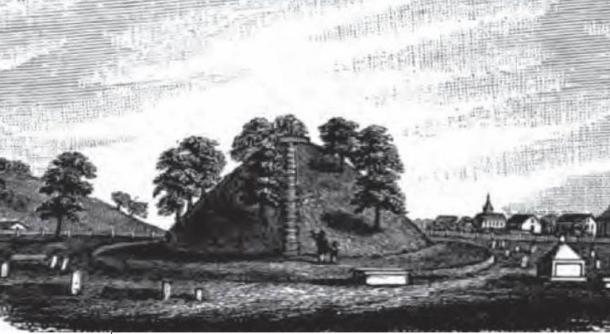
Sketch of the Conus Mound in Marietta (Wikimedia
Commons)
In 1859, T.A. Cheney made the following observations after excavating a mound inside of an enclosure in New York State:
“This embankment, with an entrance or gateway upon the east side thirty feet in width, has an entire circumference of one hundred and seventy feet…The mound, indeed, from the peculiar form of its construction, as well as from the character of its contents, has much resemblance to the Barrows of the earliest Celtic origin, in the Old World.”13
Cheney’s report states that the skeletal remains from the mound were “of very large size”.13
Similarity between European and North
American burials
“Sometimes it (the body) has been placed in a small box of stone, a cist; at other times in the hollowed trunk of a tree, or in a grave sunk below the surface of the ground; and, when a burnt body, often in an urn…”14
At Charleston, a pit beneath mound #11 contained a “skeleton fully 7 feet long” inside “traces of a bark coffin”, while the central burial and 10 attendants in the Criel mound were all “placed in bark coffins”. Mound 19 contained a cist of “angular rocks” 8 ft long, 4 ft wide and 3 ft high, in which were “fragments of a large human skeleton”.7 At the Wright, C&O, and Robbins mounds in Kentucky, transportation and possible interment of cremations in pottery vessels has been documented.15
European scholars have also noted evidence of ancient colonization. After studying American Mounds and Earthworks, Dr C.A. Adolph Zestermann (Leipzig) published an article featuring the following passage in 1851:
“These phenomena, in my opinion, point to an intimate internal connexion, for which I can find no other explanation other than a gradual migration of a portion of the human family from one part of the world to another-from one hemisphere to the other. In short, I see in it a colonization of America, by means of an immigration from Europe.”16
Besides what is apparent from mounds and earthworks, further evidence of ancient colonization is found in the realm of anthropology.
- Stephen D. Peet, The Mound Builders, 1892. https://archive.org/stream/moundbuilders00peetrich#page/n7/mode/2up
- E. O. Randall The Serpent Mound Adams County Ohio, 1905. https://archive.org/details/serpentmoundadam00randuoft
- Haak, et al. Massive Migrations from the Steppe is a Source of Indo-European Languages in Europe. http://biorxiv.org/content/early/2015/02/10/013433
- Paul Rincan, BBC News, Making of Europe Unlocked By DNA. http://www.bbc.com/news/science-environment-22252099
- Haak, et al. Neolithic Mitochondrial Haplogroup H Genomes and the Genetic Origins of Europeans. https://www.ncbi.nlm.nih.gov/pmc/articles/PMC3978205/
- Berle R. Clay, Circles and Ovals, Two Types of Adena Ritual Space. Southeastern Archaeology 6(3).
- Smithsonian Manuscript, Norris Mound Excavations.
- A. R. Sines, published in the Charleston Gazette November 14, 1926.
- Bertram Windle, Remains of the Prehistoric Age in England. http://www.archive.org/stream/remainsofprehist00wind/remainsofprehist00wind_djvu.txt
- Vere Gordan Childe, The Bronze Age, 1930. https://archive.org/details/bronzeage032071mbp
- Squire and Davis, Ancient Monuments of the Mississippi Valley. https://archive.org/stream/ancientmonuments00squi#page/n25/mode/2up
- Donald Hardesty in Probes Magazine, 1964.
- 13th Annual Report of the Regents of the University of New York. https://archive.org/stream/annualrepo1314186061newy#page/n47/mode/2up
- William Greenwell, British Barrows. http://babel.hathitrust.org/cgi/pt?id=nyp.33433074372495;view=1up;seq=15
- Nancy O’Mally, Adena Mound Ceramics in Retrospect in New Deal Era Archaeology and Current Research in Kentucky. 1988.
- Adolph Zestermann, Memoir on the European Colonization of America in Ante-Historic Times. https://archive.org/stream/cihm_42357#page/n23/mode/2up
The Adena People and Prehistoric Colonization of North America
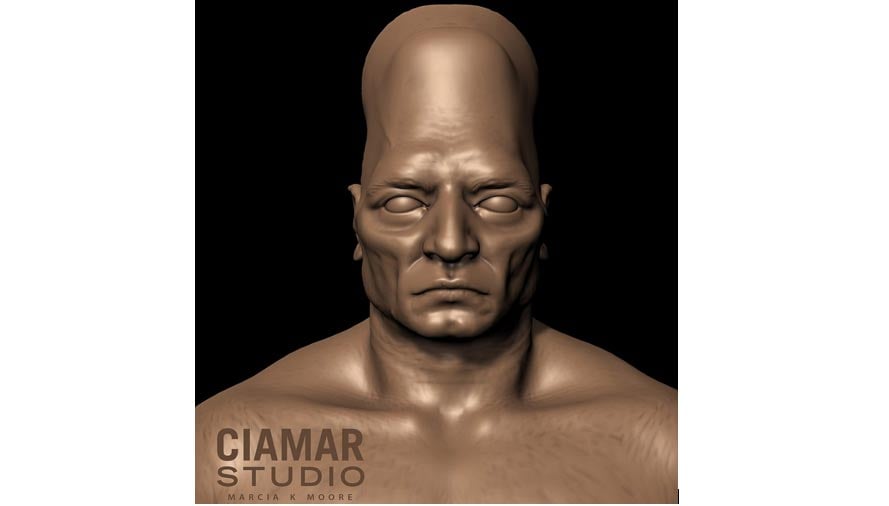
Artist’s representation of North American
giant. Credit: Marcia K Moore / Ciamar Studio. Visit http://www.marciakmoore.com/giants.html
European scholars have noted evidence of ancient colonization of North America. After studying American Mounds and Earthworks, Dr C.A. Adolph Zestermann (Leipzig) wrote in 1851:
Unique cranial features of Adena people
shared with European Beaker people
“Approximately 89% (31 of 35) of the adult males, 92 % (22 of 24) of the adult females are brachycephalic.”1
“The forehead is typically a prominent one, bordered below by fairly sizeable brow ridges. The root of the nose is of average proportions and continues on to a prominent convex bridge that is one of the prominent features of the face. The characteristic bulge of the upper and lower jaws (alveolar prognathism) is moderate in projection…Usually the cheek bones are not only of large size in themselves but they have a forward and lateral prominence…”2
Snow felt that these traits, along with the “great width of the bony chin” distinguished Adena from their predecessors and contemporaries.2
The Adena practiced artificial deformation of the occipital region, enhancing their large congenital features. Webb and Snow noted that Adena skulls were “the highest known in the world”2 with an average index of 89.5, while the deformed skulls reached as high as 100a2.
The characteristics of the Beaker People are virtually identical to Adena. Carlton Stephen Coons:
“Where Bell Beaker burials are found in central Europe, the skeletons are almost always of the same tall brachycephalic type…”
“…the browridges are often heavy, the general ruggedness frequently greater. The faces are characteristically narrow, the orbits medium to high, the nasal skeleton high and aquiline; the occiput frequently flat.”
“They form one of the rare groups in the world with a cranial length of 184mm and an index of over 80.”3
William Boyd Dawkins described the beakers’ brachycephalic crania as having “strongly marked” ridges, “high and broad” cheek bones, and jaws “presenting prognathism”,4 while Burkett described “large teeth” in the “powerful” lower jaw.5
The Beaker People practiced the same type of occipital cranial deformation as Adena:
“…there is also generally an occipital flattening which may have been caused by the use of an unyielding cradle board...”4
“One usual normal form of these crania is brachycephalic, and that decidedly so…and it is too obvious to need remark, that the mode of nursing would heighten this brachycephalism.”6
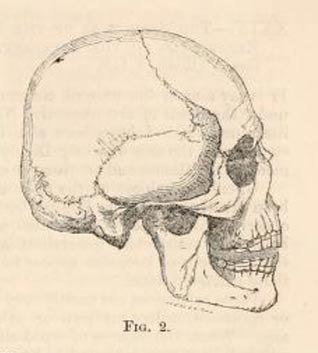
Brachycephalic Beaker skull from the Natural
History Review, 1862. Courtesy Archive.org.
Giant skeletons
A truly gigantic specimen has been documented from Castelnau-le-Lez, Southern France. In 1890, while excavating the Neolithic strata of a burial mound, Georges de Lapouge discovered the humerus, tibia, and femoral shaft of an individual he estimated to be between 11 and 12 feet tall. Lapauge’s conclusions were officially published in La Nature, Vol 18 (888) along with an image of the bones with a normal size humerous.7
“I think it unnecessary to note that these bones are undeniably human, despite their enormous size…The subject would have been a likely size of 3m, 50.”
Significantly, these remains were studied by several of Lapouge’s contemporaries, who agreed that these were indeed the bones of a giant human, as reported in The August, 1890 issue of Popular Science.8
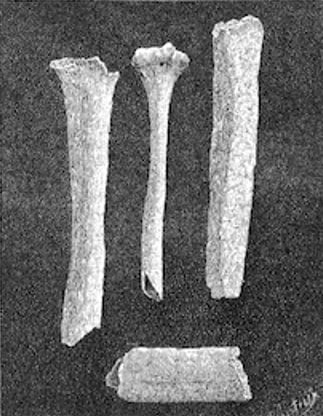
Bones of the Giant of Castelnau in La Nature,
1890. Courtesy of Wikipedia.org
The discovery of gigantic skeletons in several caves around the U.S. has been a popular subject in recent years. Less known are the documented finds on record from the dark zone in Europe.
In the late 1800s, a series of unusual remains were found at the Mentone Caves on the coast of Italy. The skeletons were the subject of an article in the November, 1895 issue of popular Science. According to the article, in 1884 a male skeleton “of gigantic size, being six feet and nine and a half inches in height…” was found. In 1892 three more skeletons were found, two of which measured “6 feet 6 inches and a half”, while the third was “ six feet ten inches and a half” estimated to stand “about seven feet four inches” while living. The crania are described as being “of unusual size and thickness”, with “unusually large” orbital cavities, and “large teeth”, the “front nearly as large as molars”. Skeletons were interred on their sides in “a cist or rude dolmen”, and were covered in red ocher. Artifacts include flint blades, shells, and deer teeth.12 Neolithic Axes have also been found.13
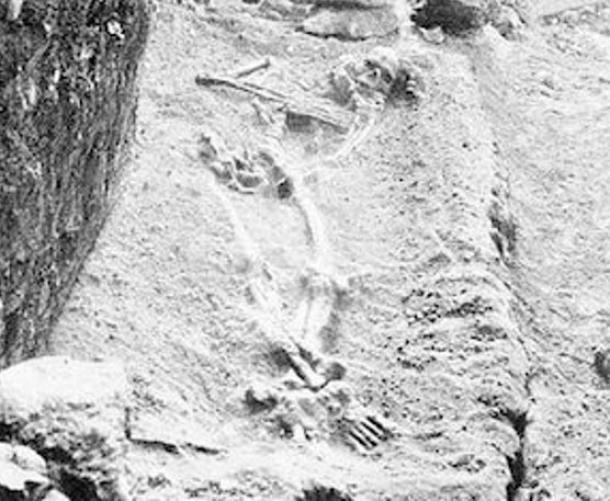
A “gigantic” skeleton in situ from the
Mentone caves. Popular Science 48, 1895. Courtesy of Wikisource.org
A similar cave burial was found at Glamorganshire (Wales) in 1824. According to W.B. Dawkins,13 a body of “gigantic stature” was found with shell and ivory artifacts, a bone awl and covered in Red Ocher.
Dating the Beaker and Adena cultures
The Unetice Culture is divided into “Older” and “Younger” phases. The earlier phase lasts from about 2200 B.C. to 2000 B.C., while the “younger” phase commences and lasts until 1800-1700 B.C., when descendents formulate the Tumulus and Trzciniec Cultures.
The Tumulus Culture phase lasts from roughly 1700-1200 B.C. before being succeeded in the Early Iron Age by the Urnfield (1300B.C.), Hallstatt, (800-500B.C.), and La Tene Cultures, identified as the “Keltoi” of ancient history.
Historically, the cultural “genealogy” of the Beaker legacy (including tumulus and earthwork construction) continues in one form or another for over 2,000 years after the initial appearance in the Chalcolithic/EBA. At the same time, a review of radiocarbon dates pushes Adena further into the past.
A Radiocarbon date of 1200-1100 B.C. was attained from the lower level of the Toepfner Mound in Ohio.14 Also from Ohio, The Kline (822 B.C.), Arthur James (803+/-115 B.C.), Munson Springs (833 and 764 B.C.), and William H Davis (1405+/-60 BC)15 mounds have all yielded very early dates. A date of 1635 B.C. was attained from the lower level of the Cresap Mound in West Virginia, which Don Dragoo determined to be too early for Adena.14 The Dover Mound in Kentucky produced a date of around 780 B.C from an upper tomb in the structure.16
Two Red Ocher tumuli at the Morton Mound group in Illinois have been dated to 1200 B.C.17 Artifacts of the Red Ocher Culture are noted as mixed with those of Adena at several mounds at the Turkey River Ring in Iowa,18 a circular ditched enclosure. Two mounds inside of the enclosure yielded dates of 600(mound 38) and 800 B.C. (Mound 39).19
In addition to obvious cultural and artifact similarities, Red Ocher is considered to be ancestral to Adena due to the brachycephalic crania found in Red Ocher graves.14
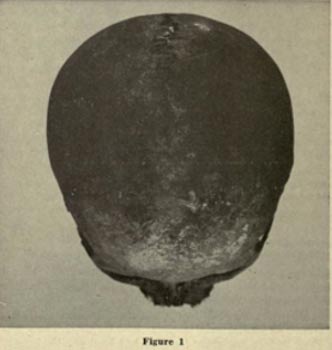
A brachycephalic Red Ocher skull, Wisconsin
Archaeologist. Coutesy of Archive.org
Many flat grave cemeteries from the Late Archaic period include Adena or Adena-like remains. At the Indian River sites in New York State, cache blades, gorgets, copper implements, and red ocher were found in contexts dating to 2448 +/-260 B.C.20
This site was believed by Ritchie,20 Webb,2 and Dragoo14 to represent the “prototype” of the Cult of the Dead of the Glacial Kame, Red Ocher, Adena, and Hopewell cultures. At the Berryhill site in Ohio (1300 B.C.), brachycephalic crania featuring occipital deformation were determined to belong to a group “ancestral” to
Adena.21 Graves also featured red ocher.
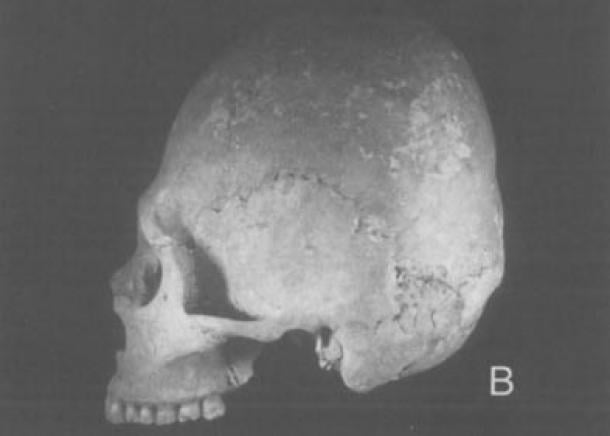
Adena like crania from the Berryhill
Cemetery, Ohio. From Pennsylvania Archaeologist, Vol 74
In West Virginia, Early Adena Fayette-Thick and Half-Moon Pottery has been found in contexts dating to 1375 and 1290 B.C.,23 and in Ohio to 1500 B.C..24 Adena Pottery is derived from the Vinette 1 pottery, which some have actually ascribed to a Western European origin.25
Thus, just as the legacy of the Zoned Beaker cultural package reaches across the span of 2000B.C. to the dawn of the first millennia A.D., Adena-type mounds and earthworks, artifact types, and cultural traits extend back into the second and possibly even the third millennium B.C. Here the source was in all likelihood associated with the Old Copper Complex. Old Copper Artifacts are strikingly similar to Bell Beaker types.
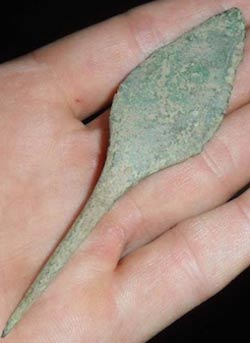
Bell beaker Palmela point, courtesy of bellbeakerbloggerblogspot.com
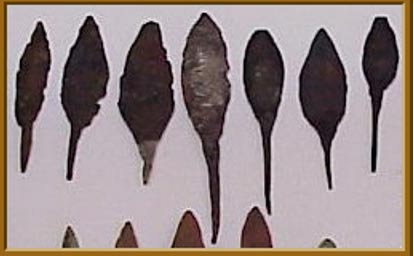
North American Old Copper “rattail” points,
courtesy of copperculture.homestead.com
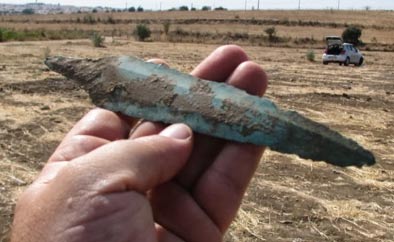
Bell Beaker Dagger, courtesy of
perdresearch.com

Beaker dagger from Crania Britannica, courtesy
of Hathitrust digital library
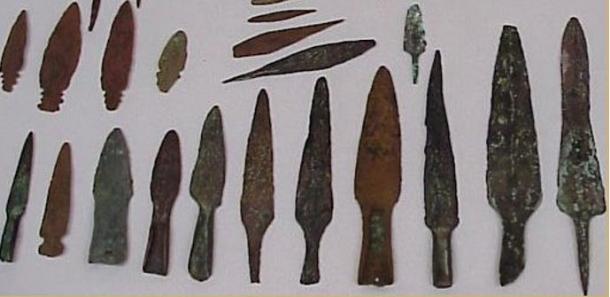
North American Old Copper tanged points,
courtesy of copperculture.homestead.com
Today, diffusionism is still considered “cult” archaeology. Yet the possibility persists that an ancient culture did indeed cross the Atlantic millennia ago.
2. Webb, Snow and Baby,
The Adena People Number 2
3. C.S. Coons, The Races
of Europe https://archive.org/stream/racesofeurope031695mbp#page/n3/mode/2up
4. William Boyd Dawkins,
Cave Hunting http://babel.hathitrust.org/cgi/pt?id=mdp.39015030526290;view=2up;seq=174
5. M.C. Burkett, Our
Early Ancestors. (1929)
6. Joseph Barnard Davis,
The Natural History Review, 1862 https://archive.org/stream/naturalhistoryre1862belf#page/290/mode/2up
7. La Nature, Vol 18,
888 http://cnum.cnam.fr/CGI/fpage.cgi?4KY28.35/15/70/536/0/0
Special
recognition to rephaim23 for rediscovering the French Giants.
8. Popular Science, August 1890
9. The Owosso Times, 1/25/1918
10. Richard Colt Hoare,
The Ancient History of Wiltshire, Vol 1
11. Daniel Wilson, The Archaeology and Prehistoric Annals of Scotland, 1895
12. Popular Science, November 1895
13. Boyd Dawkins, The Present Phase of Prehistoric Archaeology
14. Don Dragoo, Mounds
for the Dead
15. Transitions: Archaic
and Early Woodland Research in the Ohio Country, edited by Otto and Redmond
16. Webb and Snow, The
Dover Mound
17. Michael Strezewski, Mississippian Period Mortuary Practices in the Central Illinois
River Valley
18. Whitaker and Green, Early
and Middle Woodland Earthwork Enclosures in Iowa
19. Lynn M. Alex, Iowa’s
Archaeological Past
20. William Ritchie,
Recent Discoveries Suggesting an Early Woodland Burial Cult in the Northeast,
1955
21. Paul Sciulli and
James M Heilman, Terminal Late Archaic Mortuary Practices at Berryhill Cemetery
22. Mike Parker Pearson,
Stonehenge-A New Understanding: Solving the Mysteries of the Greatest Stone Age
Monument
23. See Trader, in
Woodland Period Systematics in the Middle Ohio Valley, edited by Darlene
Applegate and Robert C Mainfort.
24. James L Murphey,
Archaeological History of the Hocking Valley.
25. Alice Beck Kehoe, A
Hypothesis on the Origin of Northeastern American Pottery.
From
Ancient Origins @ http://www.ancient-origins.net/ancient-places-americas/ancient-earthworks-north-america-suggest-pre-columbian-european-contact-020417
and http://www.ancient-origins.net/ancient-places-americas/adena-people-and-prehistoric-colonization-north-america-003342
For more information about the Mound Builders see http://nexusilluminati.blogspot.com/search/label/mound%20builders
For more information about giants see http://nexusilluminati.blogspot.com/search/label/giants
- Scroll down
through ‘Older Posts’ at the end of each section
Hope you like this
not for profit site -
It takes hours of work every day by
a genuinely incapacitated invalid to maintain, write, edit, research,
illustrate and publish this website from a tiny cabin in a remote forest
Like what we do? Please give anything
you can -
Contribute any amount and receive at
least one New Illuminati eBook!
(You can use a card
securely if you don’t use Paypal)
Please click below -
-
Spare Bitcoin
change?
For further enlightening
information enter a word or phrase into the random synchronistic search box @
the top left of http://nexusilluminati.blogspot.com
And see
New Illuminati – http://nexusilluminati.blogspot.com
New Illuminati on Facebook - https://www.facebook.com/the.new.illuminati
New Illuminati Youtube Channel - http://www.youtube.com/user/newilluminati
New Illuminati on Google+ @ For
New Illuminati posts - https://plus.google.com/u/0/+RamAyana0/posts
New Illuminati on Twitter @ www.twitter.com/new_illuminati
New Illuminations –Art(icles) by
R. Ayana @ http://newilluminations.blogspot.com
The Her(m)etic Hermit - http://hermetic.blog.com
DISGRUNTLED SITE ADMINS PLEASE NOTE –
We provide a live link to your original material on your site (and
links via social networking services) - which raises your ranking on search
engines and helps spread your info further!
This site is published under Creative Commons (Attribution) CopyRIGHT
(unless an individual article or other item is declared otherwise by the copyright
holder). Reproduction for non-profit use is permitted
& encouraged - if you give attribution to the work & author and include
all links in the original (along with this or a similar notice).
Feel free to make non-commercial hard (printed) or software copies or
mirror sites - you never know how long something will stay glued to the web –
but remember attribution!
If you like what you see, please send a donation (no amount is too
small or too large) or leave a comment – and thanks for reading this far…
Live long and prosper! Together we can create the best of all possible
worlds…
From the New Illuminati – http://nexusilluminati.blogspot.com
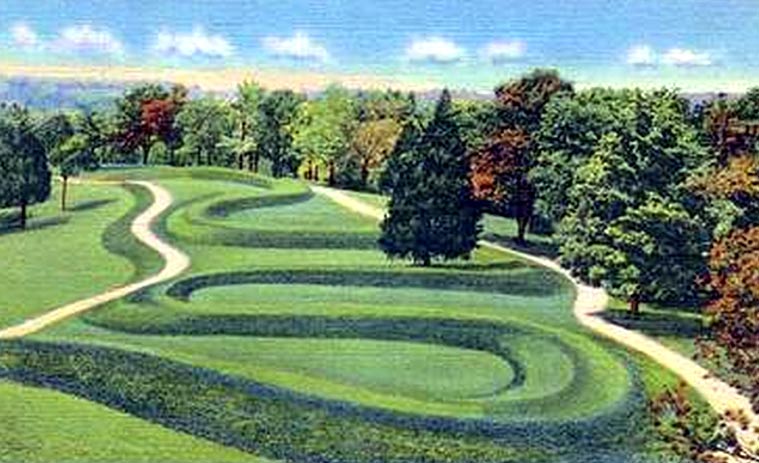
No comments:
Post a Comment
Add your perspective to the conscious collective